Postal cheque service envelopes
History of the postal payment traffic in the Netherlands
Throughout the ages post and money traffic have been closely connected. When the number of people that learned to read and write increased, the amount of post grew. A continuously expanding network of post offices enabled a proper handling of all this postal traffic. But people got more and more need to send money to family, acquaintances and business relations. The countrywide covering network of the Postal Service was better equipped for this than the network of the banks, thus it was not strange that this service landed at the Postal Service.
Following the neighbour countries the Netherlands postal service started with postal money-orders. With the "General Instruction" in 1810 the "assignations" (in Dutch: assignaties) were introduced. The sender had to (let) fill in a postal order form at the post office. 5% of the money to be tranferred had to be paid to the Postal Service as poundage. Next the Postal Service transported the money in separate packings (articles coté's), but the sender had to send the postal order himself. With this form the amount could be cashed at the post office, against payment of the stamp-duty.
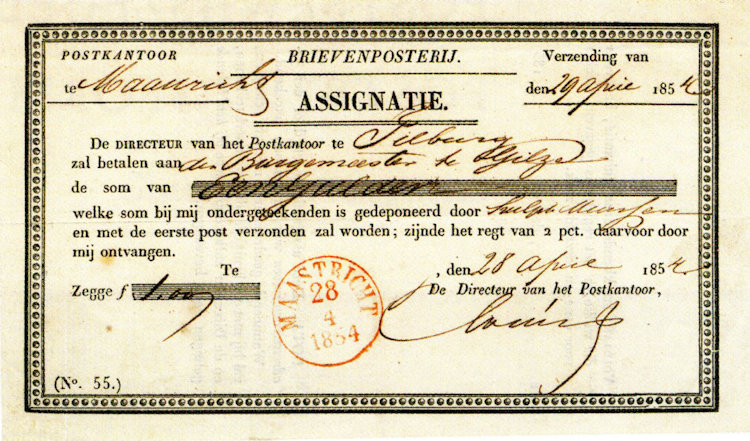
A postal order form or "assignation"
In the postal law that became effective January 1st 1871 the postal duty was fixed at 5 cents per postal order up to 12.50 gulden (the old Netherlands currency before introduction of the euro). For every 12.50 gulden in excess 5 cents extra had to be paid.
By the introduction in England of money-orders to bearer, postal notes, also in our country the discussion started whether this should be introduced here. Especially when France introduced comparable "bons de poste". The choice was made to pay the amount to be tranferred with stamps. When the normal (post) stamps would have been used it was not traceable anymore how many were used for shipment of letters, and how many for postal notes. Therefore new stamps were needed: postal note stamps (in Dutch: postbewijszegels). After a short discussion whether it should be 6 or 7, the final choice was for 7 postal note stamps with the values 1, 1½, 2, 3, 4, 5 en 10 gulden. With 3 of these stamps every amount between 1 and 19 gulden, rounded to 50 cents, could be transferred.

The complete series of postal note stamps (Postbewijszegels)
You had to buy a form and the required stamps. The right part was cancelled. The left part was sent to the benificiary, who took it to the post office and cashed the money. This system has been in function until 1900. Advantage compared to the former way of transferring money was that is was not necessary to send cash money from one to another postal office.
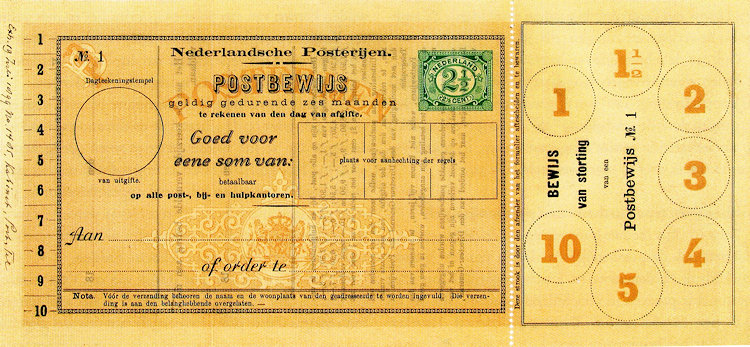
Postal note (postbewijs)
In 1881 the Dutch State Savings-bank, in Dutch Rijkspostspaarbank, was established. The bank became a responsibility of the Ministry of Public Works, Trade and Industry. Transactions were possible on every post office within the Kingdom of the Netherlands. The first director was Arnold Kerdijk, a progressive liberal who saw in the general savings-bank a possibility for raising the working class.
The Rijkspostspaarbank was a big success. Especially the successor of Kerdijk, Armand Sassen, has made a large contribution to this. In the 50 years after the establishement the number of accounts grew to around 2.2 million in 1931, on a total population just less than 8 million.

Naming of the Netherlands postal banks through the years
The Postal Cheque and Giro Service (in Dutch: Postcheque- en Girodienst) played an important role in the development of the payment traffic. Established in 1918, a big mechanization operation was executed in 1923. Aim was to centralize the administration of the giro accounts and mechanize it with punch cards. This project was executed with big problems. After intervention by minister of Public Works van Swaaij the PCGD was even forced to close down for a year. Not earlier than in September 1924 the PCGD was re-opened.
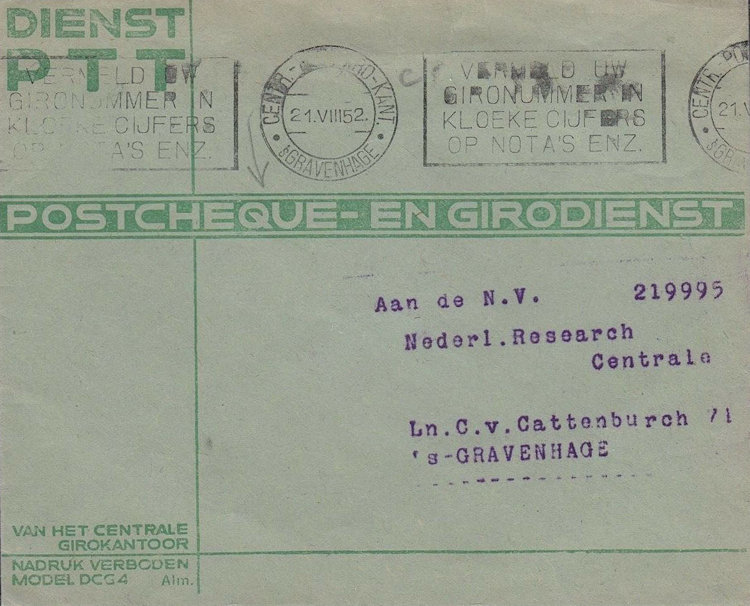
Postal cheque envelope 1952 without advertisements. Note the account number behind the name.
The original concept of the giro is a social payment system where "everybody" has an account, and people pay each other in the form of a transfer between 2 accounts.
By effective use of the network of the postal services and intensive automation, it was in the 70–ies possible to pay through the giro service within 2 days.
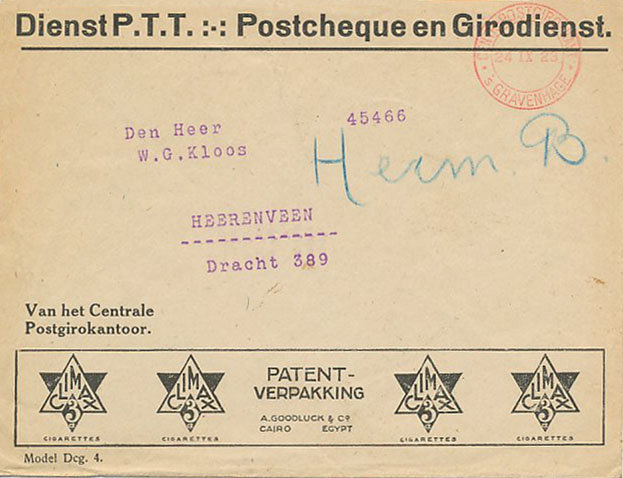
Postal cheque envelope 1923 with advertisement. Also here the account number behind the name.
The principle was that the payer paid through the payment service, and not by a cheque to the receiver/supplier. In case of a cheque the receiver cashed it, and by this withdrew money from the account of the payer. This enabled a lot of fraude possibilities (against which legal protection means against forging of cheques were required), which are not necessary when the payer gives the instruction to pay directly to his (trusted and trustworthy) payment service, or sends it in (port free) envelopes.
Examples of port free postal giro envelopes:
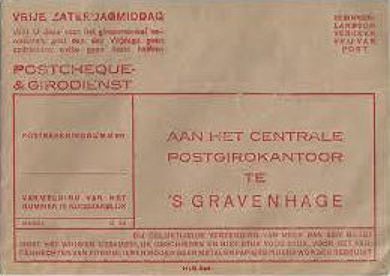
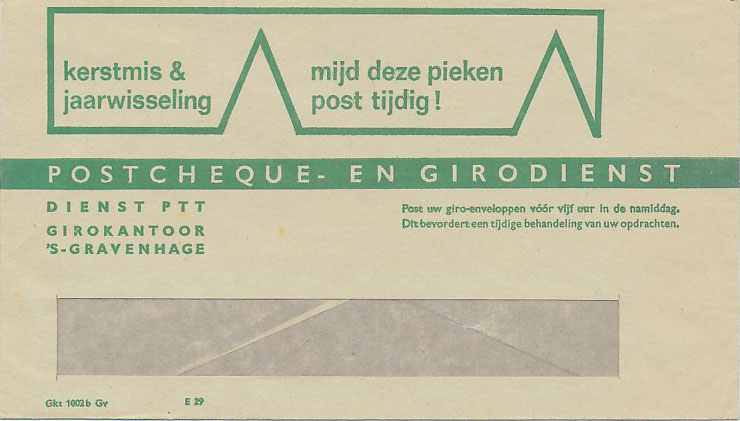
Postal cheques service in Belgium.....
The institute was established by law of December 28th 1912 (the budget law for the year 1913, in which only the establishement of a postal service of current accounts, cheques and transfers is mentioned) and the Royal Decree of February 23rd 1913. The names varied. From 1913 on Dienst der Postcheques en Overschrijvingen (service of postal cheques and transfers) was used. After the Second World War Bestuur der Postchecks or in French Office des Chèques Postaux (administration of postal cheques) was common. Around 1990 the name Postcheque (postal cheque) was introduced. In financial circles people were speaking from the Financiële Post (financial post) and used the abbreviation BCH.
in Germany.....
At the introduction of the postal cheque on January 1st 1909 13 Postscheckämter (PSchA) participated in the countrywide organization: Berlin, Wroclaw, Danzig, Frankfurt am Main, Hamburg, Hanover, Karlsruhe (Baden), Cologne, Leipzig, Munich, Nuremberg, Ludwigshafen (Rhine) and Stuttgart. On April 1st 1916 Königsberg (Prussia) joined. As replacement for the postal cheque office from the free city Danzig, an office in Szczecin was opened on October 1st 1919.
Because of the large number of transactions the
Postscheckämter Essen, Erfurt and Dresden also joined in 1920, and in 1921 Magdeburg and Dortmund followed. After the Saar referendum in 1935 Saarbrücken finally followed. In 1938, during the collaboration between Hitler Germany and Austria, the Postscheckamt Vienna joined. During the 2nd World War the Postscheckämter Aussig, Danzig, Luxembourg and Strassbourg (Alsace) were included.
in Switserland.....
Around 1900 the private and cantonnal banks were no longer able to offer enough cash to the Swiss economy. For this reason the National Council of Basel and Colonel Carl Koechlin, together with 5 other signatories, brought a motion forward. With this they laid the foundation for introduction of a postal cheque and giro service. For the processing of payment transactions the office network was very well suited. At that moment it already contained more than 3000 access points spread over Switserland. In 1906 Carl Koechlin opened the first postal cheque account at the Postcheckamt Basel.
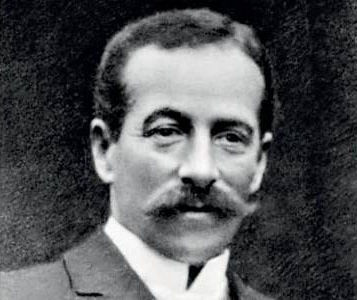
Carl Koechlin
and in France
Also France got a postal cheque service. There even now a lot of transactions are still paid by cheques.
The postal cheque services form an integral part of the postal services. Internal rules and agreements of the postal services were therefore also applicable for this service, like the port free shipment of post: often account overviews after transactions.
As far as I know it was, and except from the Netherlands still is, possible to get payed advertisements placed on the envelopes of the postal cheque service. These sometimes beautiful advertisements show parts of a subject that you don't see on other philatelic material. This makes these envelops interesting for thematic collectors like we are.
Hereafter some examples of this kind of publicity:
Belgium: postal cheque envelope 1923 with advertisement for FN.
Still included was the account overview
after a payment of 60.50 BFr.
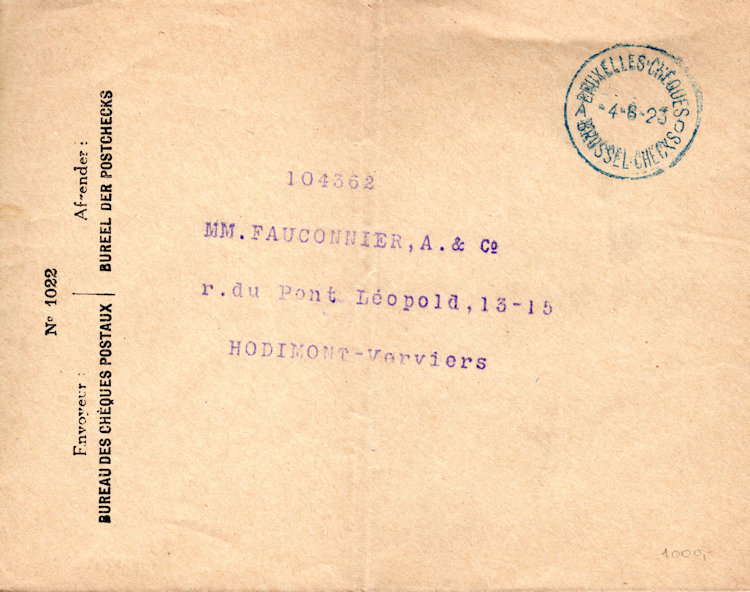
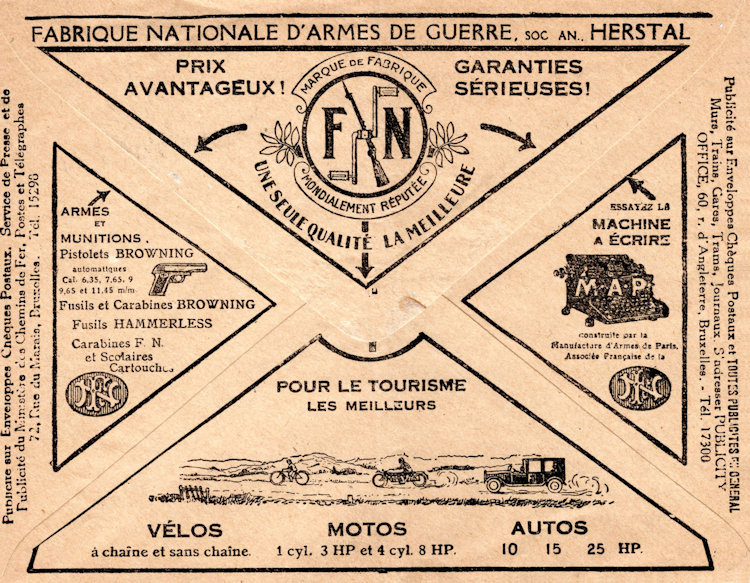
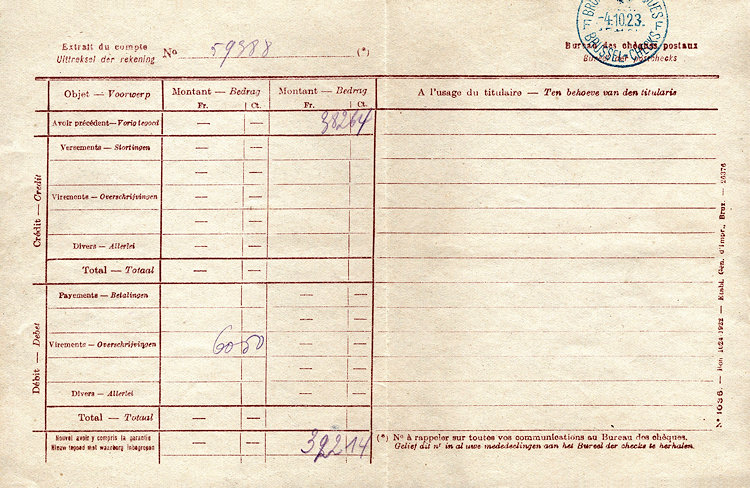
Belgium: postal cheque envelope 1933 with advertisement for FN trucks, the same FN that also built motorcycles.
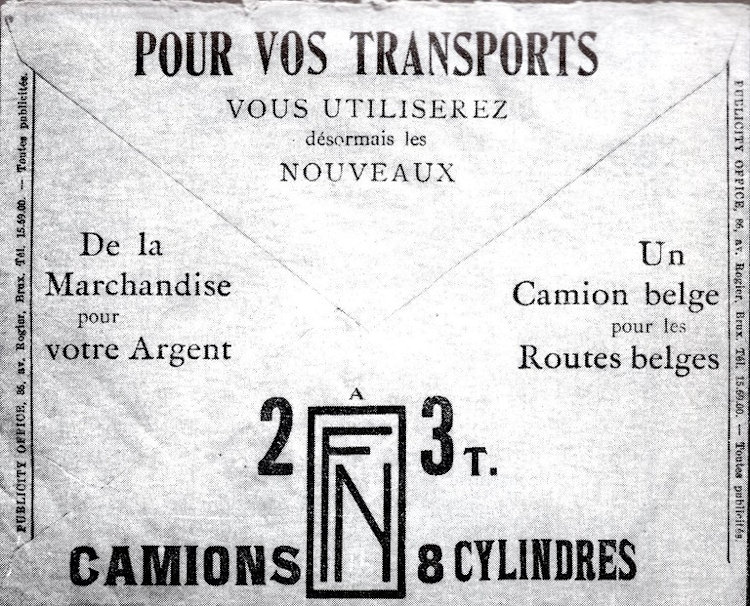
Belgium: postal cheque envelope 1953 with different advertisement for FN.
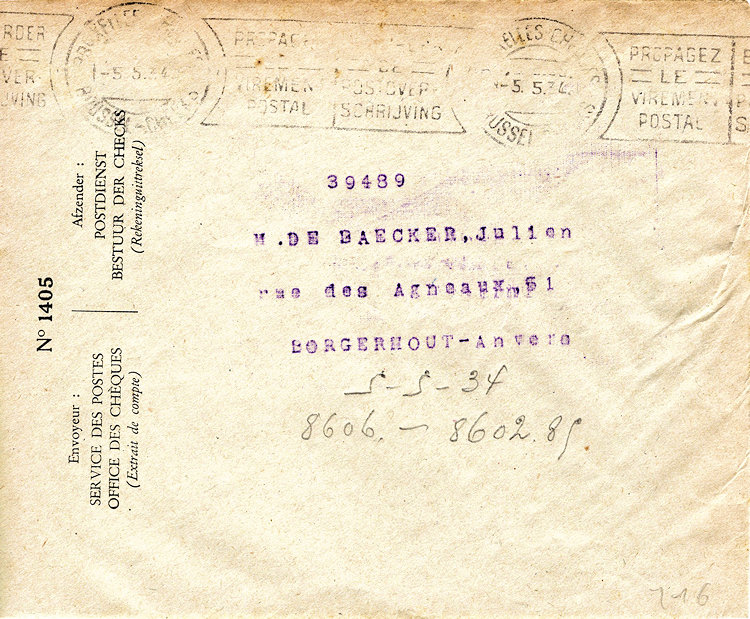
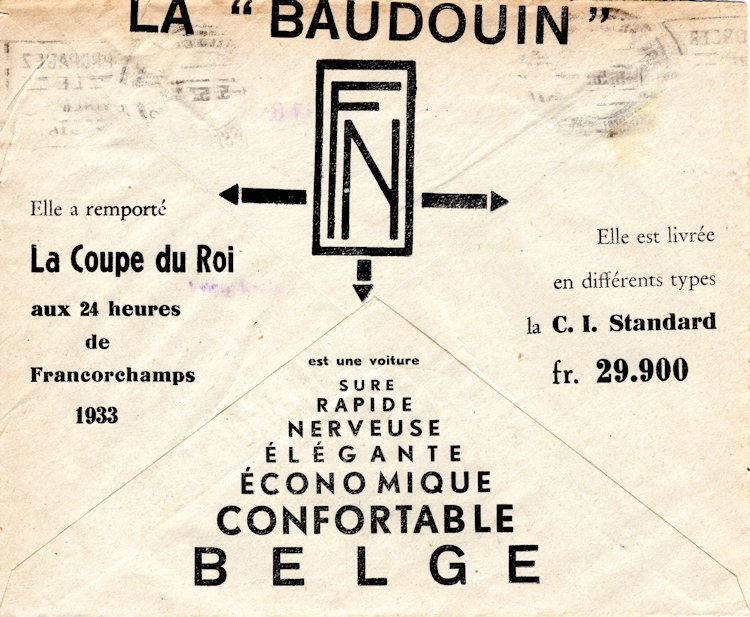
Belgium: postal cheque envelope 1934 with not only an advertisement in the backside of the envelope (Bosch)
but also on the frontside (Peint – Neuf).
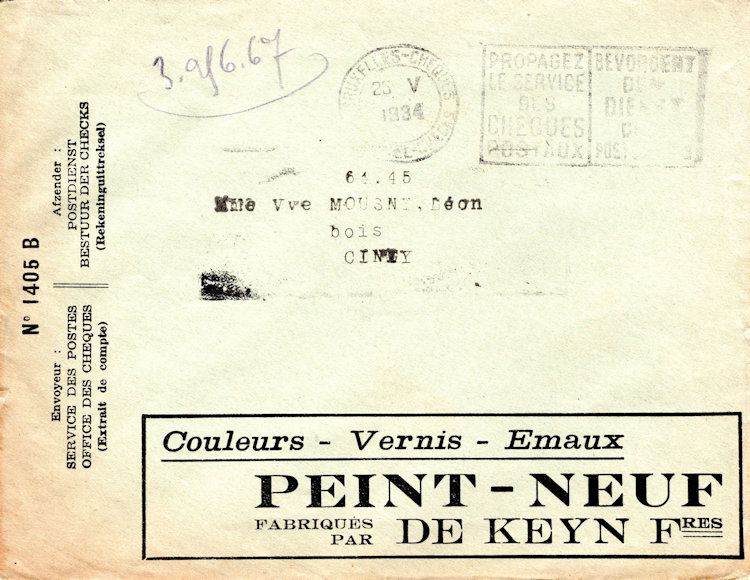
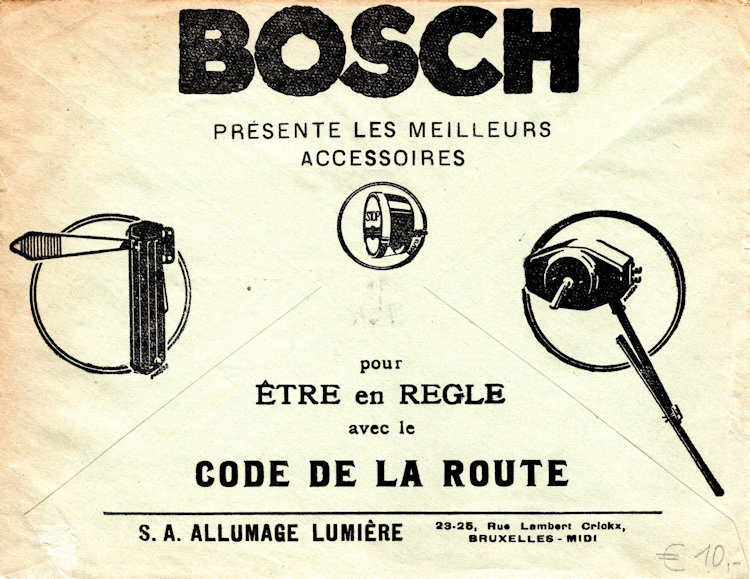
Germany: postal cheque envelope (see stamp PSchA: PostScheckAmt) with advertisement
on the backside for Valvoline products.
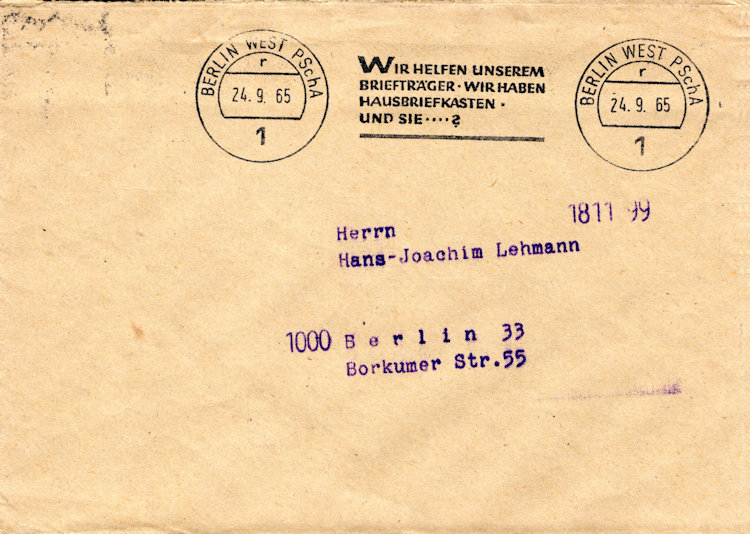
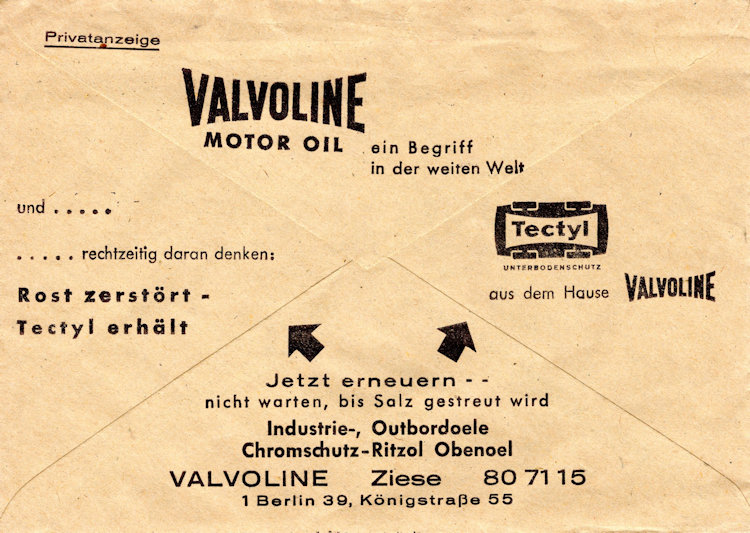
Germany: postal cheque envelope (see stamp PSchA: PostScheckAmt) with advertisment on the frontside
for car-motorcycle-bicycle tyres. Nice double-print on the backsiode of the preceding envelope.
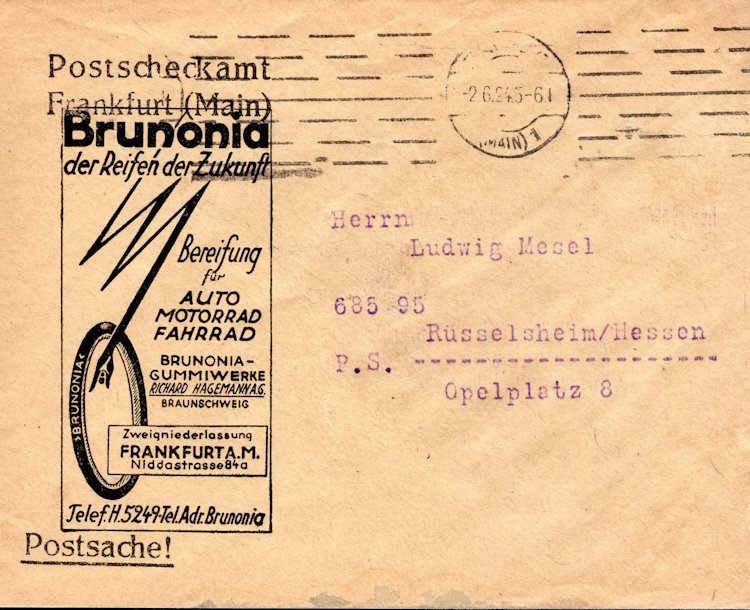
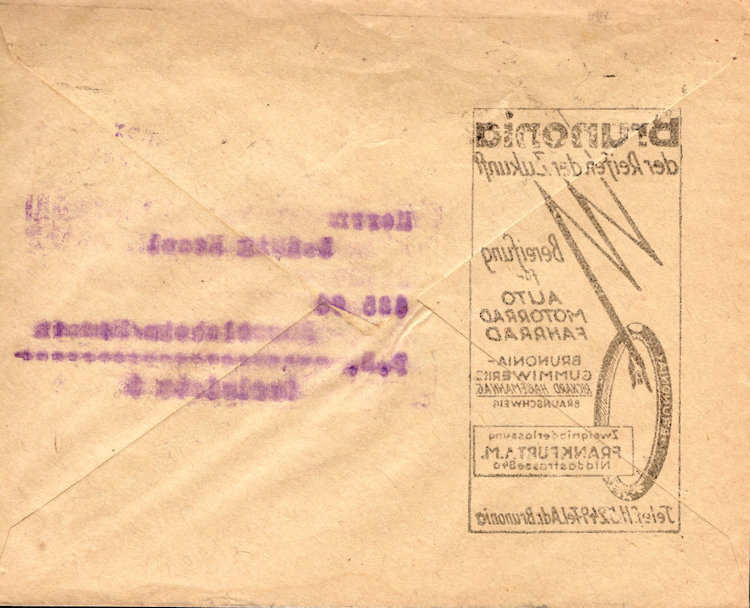
France: postal cheque envelope with advertisement on the backside for
Purarjan, a polishing fluid for chrome.
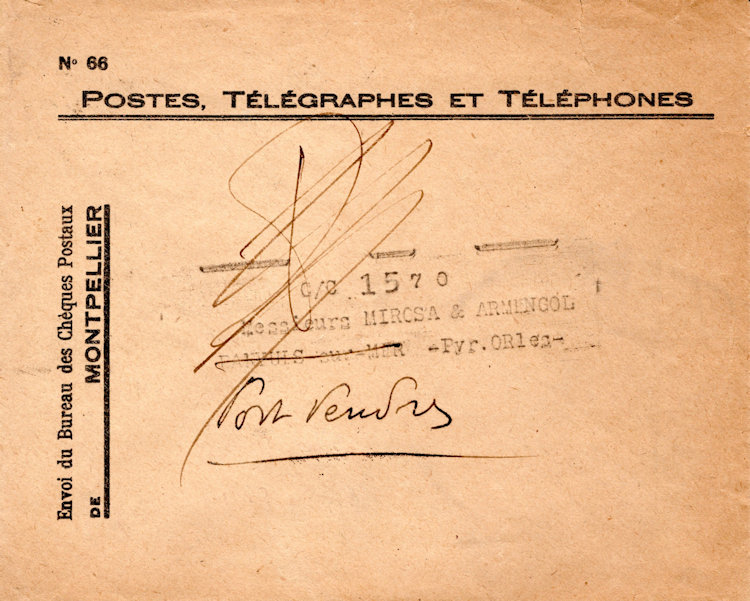
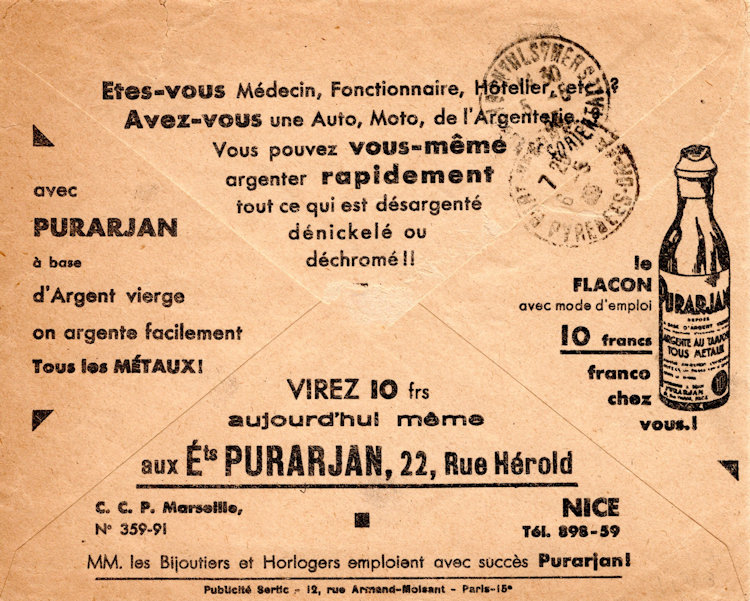
France: Four different postal cheque envelopes with advertisements on the backside for Le Motorist.

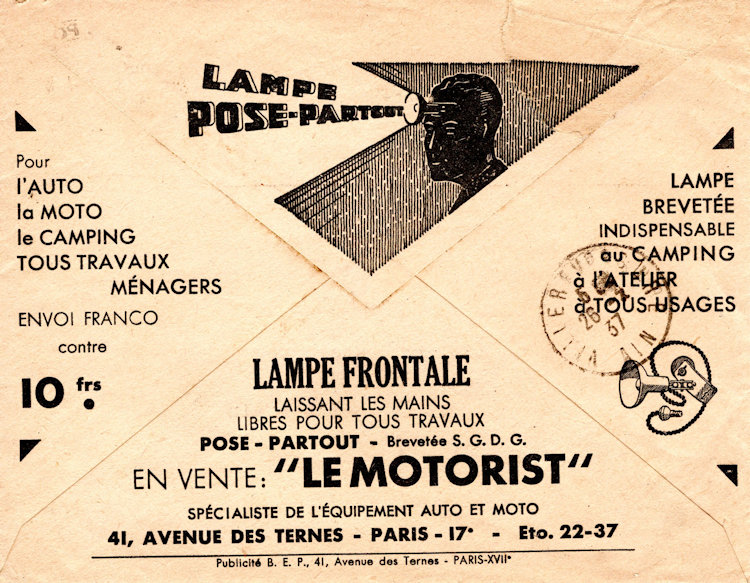
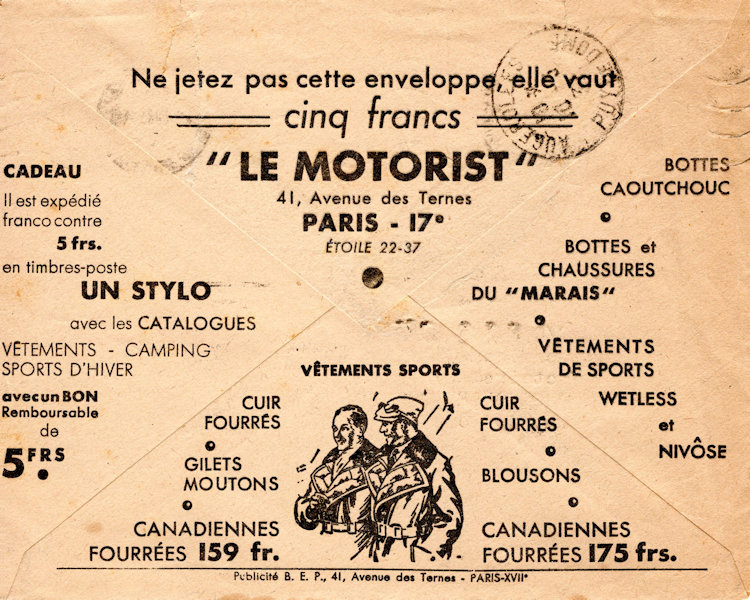
From the last envelope, next to the front- and backside, also a receipt of the transaction and an
account overview
after transaction. Both the receipt and the overview were still in the envelope.

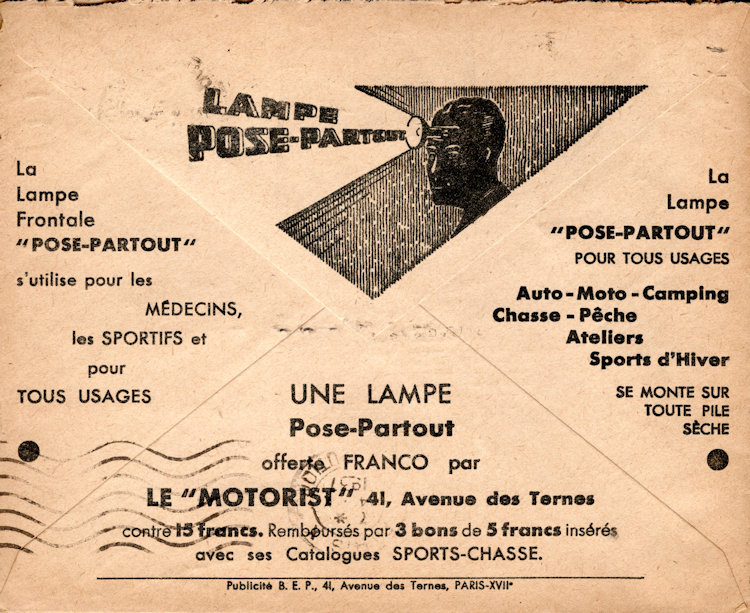
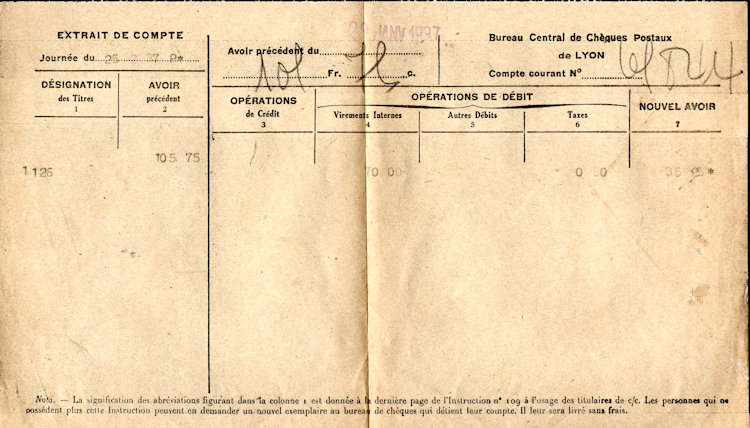
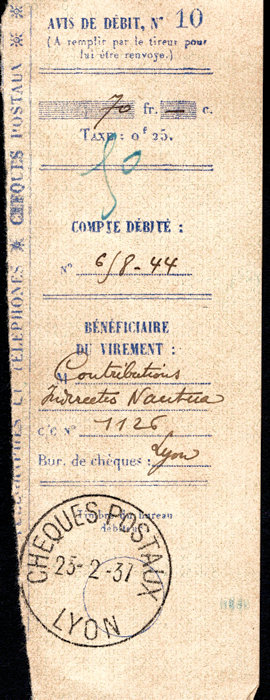
Advertisement for Le Motorist in a motorcycle magazine. This was a large shop in the Paris'
Avenue de Ternes, no 41,
where many articles for outdoor sporting could be purchased.
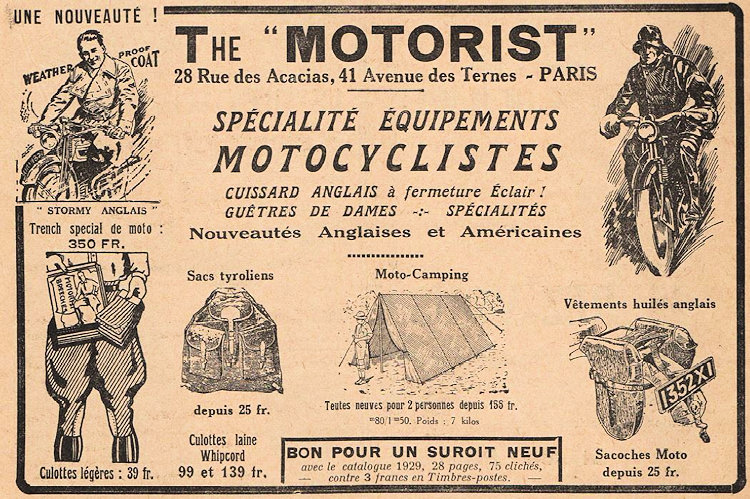
Modern Postal cheque envelopes with advertisements: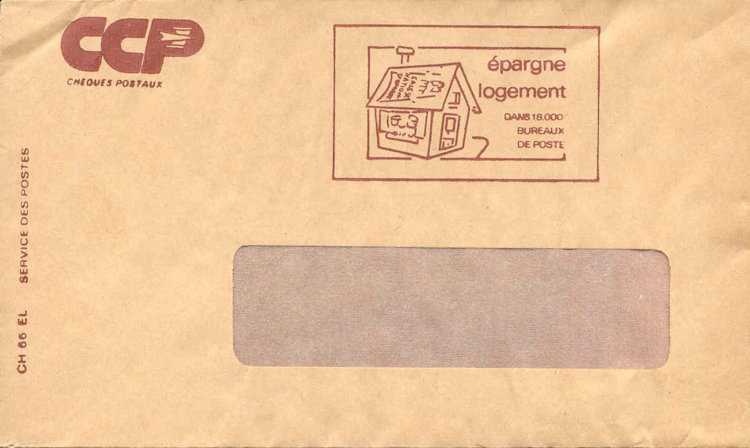
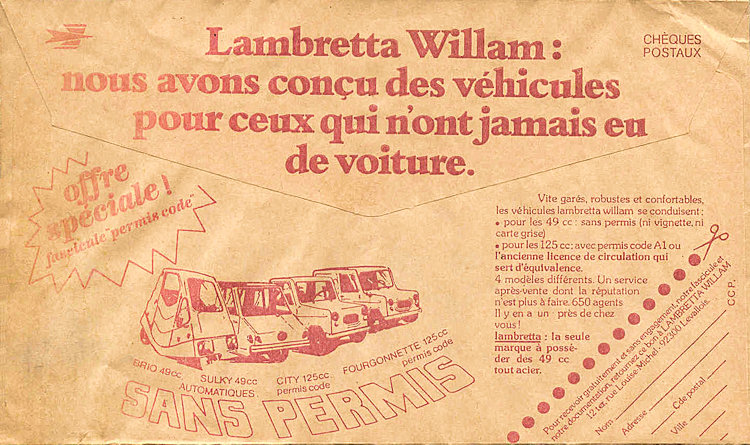
When you choose to participate in an exposition with (part of) your collection, the postal cheque envelopes for sure should be included. They are regarded to be part of the philatelic element port freedom.
Nico Helling
Top - Back to former page - Home |
































